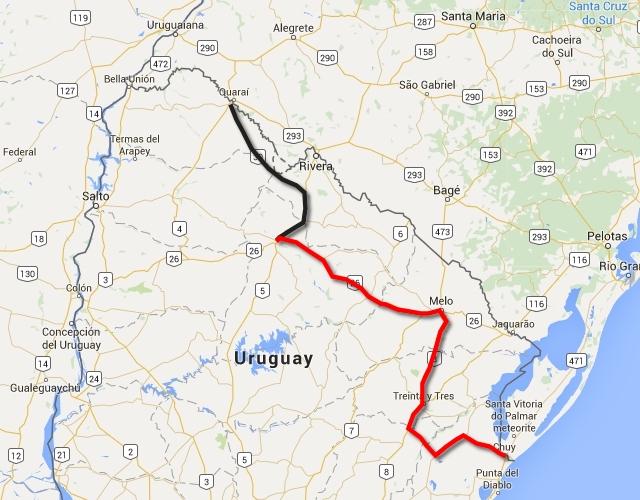
Nothing compares to the simple pleasure of a bike ride. J.F.Kennedy
Search this website
To the Atlantic Ocean
Artigas, Tacuarembó, Melo, Treinta y Tres, José Pedro Varela, Lascano, Chuy
My main worry upon arrival in Uruguay was to withdraw money. I was stashed with Argentinian pesos, which I could exchange in the worst case scenario for Uruguayan ones. I wanted to see if withdrawal from an ATM was possible. Artigas was quite big and had several ATMs. I stopped at Scotiabank and already the first machine spat out the requested money. After my previous experience in Argentina, where I could never take out more than 1000 pesos per transaction, I did not request any more. I withdrew the amount one more time.
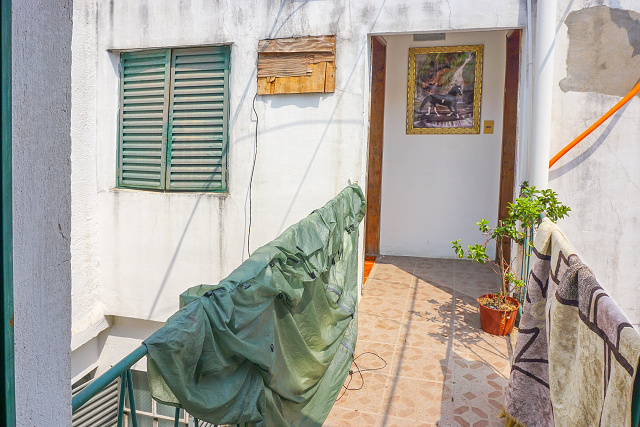
Artigas: Drying out my tent on the hotel railing
A Frenchman in a campsite in Puerto Iguazú had warned me that Uruguay was very expensive. I was curious about this. I went to a hotel in the center and inquired about their rates – CZK 1300 ($65). Quite expensive for that country. I did not give up and got the receptionist to describe the route to a cheaper hotel and, 15 minutes later, I had accommodation for CZK 560 ($28). I happily took a shower, placed the tent over the rail to dry and went to ask for "agua caliente" so I could make Mate. Asking for hot water always works wonders! They immediately try to help you and are pleased that you enjoy their national beverage.

Artigas: Memorial locomotive in the park

Artigas: Graffiti on locomotive cabin
I purchased food for the next day in the supermercado nearby. I was not sure if I would have to sleep out somewhere in the wilds. The prices were a little higher than in Argentina but using my credit card was not a problem. Instead of a passport to confirm my identity I used my driving license. In the center, I asked at the tourist office where I could eat dinner. They sent me to the restaurant of a Casino where they served an evening buffet. They dismissed my worries that it might be too expensive saying it would be "ecónomico". They were right. I ate over half a kilo of meat – schnitzel, lamb, meat grilled on the spit, with mashed potato, noodles, potato salad, beetroot salad. I pushed in several cakes and coffee and paid the easily acceptable CZK 240 ($12). I could never have found such a place at that price back home. Hiccuping, I rolled back to my hotel nearby and looked forward to my energetic cycling the next day, considering such a foundation.

Artigas: Square with police headquarters in the background
My Spanish
is of course terrible. Yet I managed to get around with it. I often spoke by using only words in the infinitive, but the people there were very kind and did not mind such details. The main thing was that they understood what I wanted. The short time spent in Brazil, however, had been impossible for me, as I did not understand Portuguese at all.

Artigas: Afternoon siesta
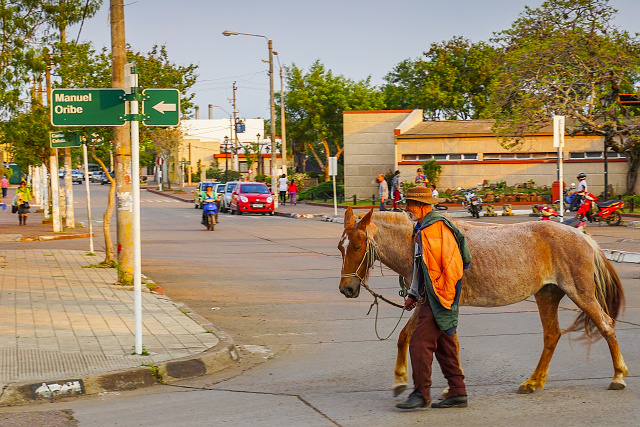
Artigas: Gaucho in the street
Awful Weather
Towards evening, a storm started to brew, accompanied by heavy rain and a wild cyclone. The following morning did not seem any better. Impossible to cycle in that. I am not suicidal enough to let the wind blow me under the wheels of a truck. The weather forecast was no good either, it would remain like that for another 2 days. I considered my options: stay in Artigas or take the bus to Tacuarembó, 211 km away. At the bus station, I found that a bus was departing at midday. They asked me if I wanted to buy a ticket. I answered "más tarde" (later). They warned me that they only had three seats left, so I purchased the ticket and got ready to travel by bus.
Around 10:00 the weather improved, the rain and wind weakened and I speculated whether I had been too rash in choosing the bus ride. The ticket cost CZK 300 (approx. $15) so I did not change my mind. The bicycle fitted into the bus, I bound it to the poles, so that it would not bang against the bus too much. I also placed it in such a way that its right side with the chain, chain wheel and derailleur were facing the open space and would not be knocked against the bus. We got going and, already after an half an hour, I knew that I had made the right decision. The rain storm returned in full strength, the dusty sections of the road were bathed in red mud. The asphalt sections were full of potholes filled with water, without any side lanes.
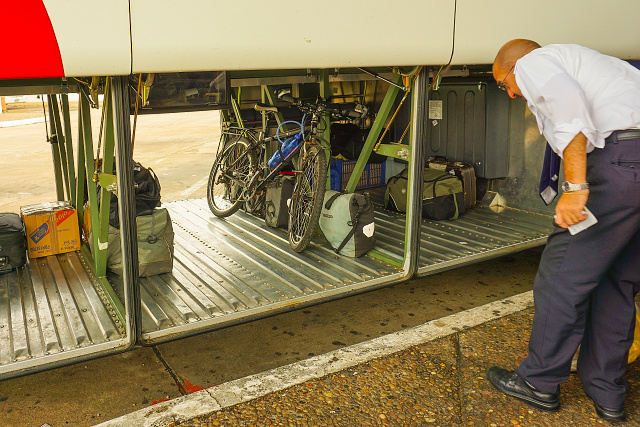
Artigas: The bicycle fitted comfortably in an upright position in the bus
Even though it was a long-distance bus to Montevideo, it stopped at every meadow when someone waved at it. It seemed to be a private business of the crew. These passengers did not receive any tickets and often there were arguments with the conductor about the price. The bus was fully loaded, so they had to stand in the aisle. But they usually only traveled with us for a few kilometers.
Three and a half hours later, we reached Tacuarembó. It was only raining there, the wind had died down. The bus terminal was atypically placed on the city outskirts. Usually they were almost always in the center. My bicycle was intact. Together with the bus fare, it had been cheaper than staying in Artigas.
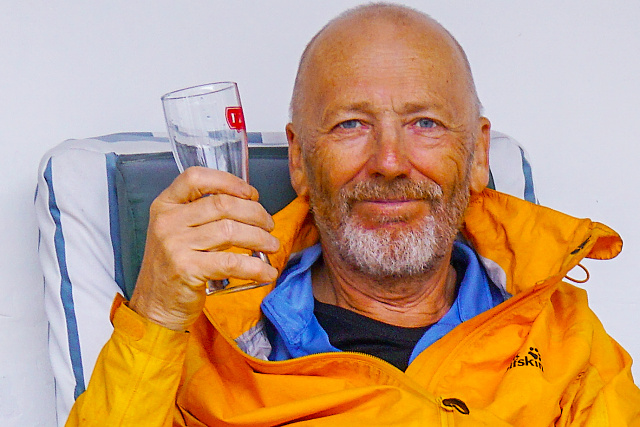
Tacuarembo: The crossing was problem-free, nothing was lost and I celebrated it with a drink in the backyard of the hospedaje
The weather was still horrible. Rainstorm at night with thunder. It rained persistently in the morning, I lay in bed until almost 09:00, when the rain eased off notably. I left at 10:00, dressed in rainproof clothes. 10 km later, the rain subsided, I let the jacket and trousers dry on the carrier. I was lucky as I did not need to wear them again that day.

15 km E of Tacuarembo: Forests lining the road
The countryside was interesting, slightly hilly, forested. Except I found the water was a little over-represented. Probably the result of the rainy days. Normally the road surroundings and pastures were not flooded.
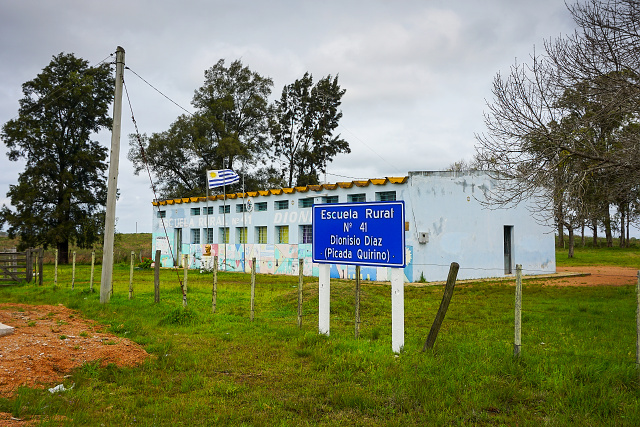
Near Villa Ansina: Country school
60 km later, I arrived in Villa Ansina, the biggest town on the route to Melo. It was rather a small village, however, quite significant to me. I purchased some bread in a bakery, together with a surprisingly tasty yeast cake with pudding, which I preserved for the following morning. I ate in a pub and then I could continue cycling.

Villa Ansina: Statue of the Virgin Mary dominates the town entrance

Villa Ansina: Cemetery
The road quality worsened, long dusty sections were damp, so luckily the dust did not rise into the air and even the viscous mud did not form on its surface. The asphalted sections were no better, full of potholes filled with water. Luckily the traffic was almost non-existent, I could cycle in the middle of the road, where the road was least damaged.
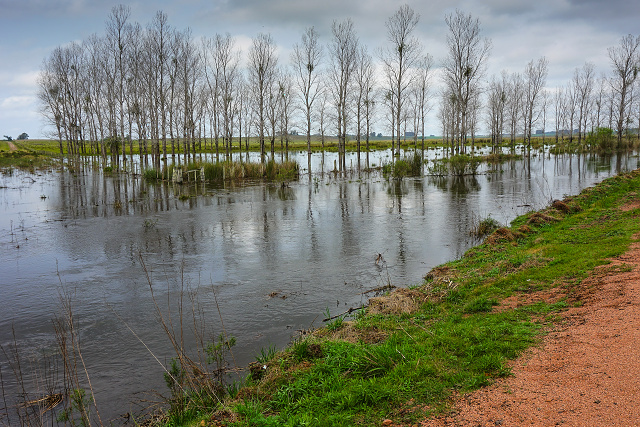
Villa Ansina: Trees with birds' nests near the road
It became obvious that I was to find a place for the night along the road. I spotted some sites, but they were rather hard. The grass was flooded in water, even the hills in that region had no forests either. In a small village of probably 15 houses, I spotted a sports stadium with a grass field and an outside table and bench. Beside it was a small house with a sign Policia. To make sure, I went in and asked if I could pitch my tent in the stadium.
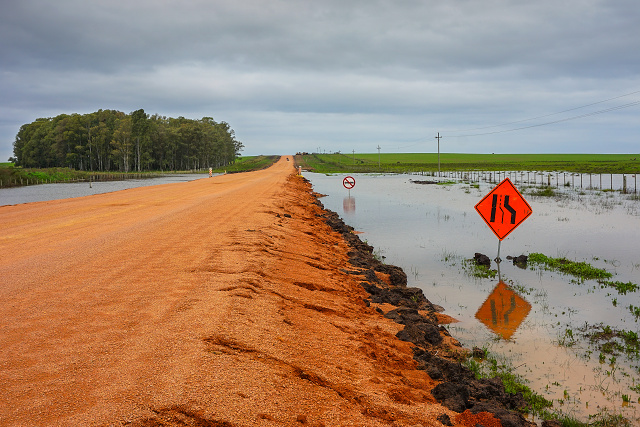
E of Villa Ansina: A dirt road with flooded surroundings
The wife of the policeman, to whom I recited my request, was at home with the children. While their dog watched me warily and a cat tried to rob me of part of my supplies located in a net bag above my pannier containing my sleeping bag, the lady telephoned furiously. I thought that it would not be such a problem and waited. The denouement was surprising. The lady informed me that it would rain during the night and therefore she organized an overnight stay for me in a small house across the road. I thought it was unnecessary, it did not seem as if it was going to rain, yet I did not refuse the help offered.

Puntas de Cinco Sauces: My dormitory
When I unwound a wire holding the small gate to the garden of the house, I tore my shorts on another piece of wire which was sticking out. There was a 5x5 cm L-shaped hole on the front of my shorts. I have to admit that the shorts were worn out and the local humidity was not doing them any good. The house was not so messy and the newly laid concrete at the back was flat and clean, so I lay my head down there. I used the evening light to stitch up my shorts. It did not go so well. My wife back home is very skilled, so I lack the necessary sewing experience. I knew the technique – first tack and then sew properly. In the end, I did just the latter. The result was not very appealing, but it held.
During the night, I became grateful to the policeman's wife. A rainstorm raged for several hours and it was still raining in the morning. I headed out at 08:30 in light rain and, half an hour later, could take off my rainproof clothes. I reached Las Toscas village, where there was a store. I purchased a snack and lunch, asked to boil some water and made some Mate. I was fully equipped to cycle to Mela, which was 85 km away.

Las Toscas: Entrance gate of cemetery
En route to Mela
Everything changed, it started to rain heavily and Mother Nature was not sparing me in any way. After midday, an hour-long storm arose, which gave me a big scare. I was just cycling over a plateau with a very few trees, so I hid out there, although I am generally a small person. I anxiously counted the seconds, the shortest latency was 4 seconds, the lightning was only 1.3 km away. Then the storm subsided, I had hardly relaxed for a second when another rainstorm began. A truly demanding half an hour, there was no place to hide, I had to cycle in it, if nothing else, to keep warm.

Near Mìlo: Farm entrance
It did not end there! The half an hour pause with only light rain ended in a wide and strangely transparent white wall which I approached. Hailstones – really big ones, 1-2 cm in diameter. Impossible to cycle in them, they would have fractured my nose. This is why my only option was to stand still, hands beside my body to take up the least possible space, while the hailstones hit my helmet and shoulders. Then again, heavy rain and finally 10 minutes of sunshine. And to make sure I would not relax, the last 25 km were accompanied by a respectfully heavy headwind.
I arrived in Mela, right in the center and took the very first hotel. I was happy to have it all behind me.
In the evening, I checked the map. The nearest town of Treinta y Tres was 110 km away. I had wrongly believed it was 70 km. It became obvious that it would be a challenge. I planned to leave at 08:00 at the latest. I succeeded. The roads were still wet from the previous night's rain, but it was not raining at least.

20 km S of Mìlo: Road and surrounding countryside
The hills were impressive, which is also why this section was called Cerro Largo. Around midday, the wind started to be irritating. For half an hour, it was even accompanied by showers which made me wet, just to keep me fit and to make sure I would not think that the weather had improved. The countryside, however, was very attractive, reminding me of the North Island of New Zealand.

Arbolito: Surroundings of the road
I also understood why the local roads were so terribly bumpy. I saw the socialist road work team and that was something. Six men were repairing the potholes in the road. They must have been professionals: three of them were sweeping the water from the holes with brooms, the other three holding shovels were filling up the holes with concrete. It was almost only sand mixed with water. They probably needed the cement back home, or I do not know. When they were in a good mood, they even tapped the little pile slightly. Usually they left it as it fell off the shovel. No finisher or roller behind them. If they had not done any work at all, the result would have been the same.
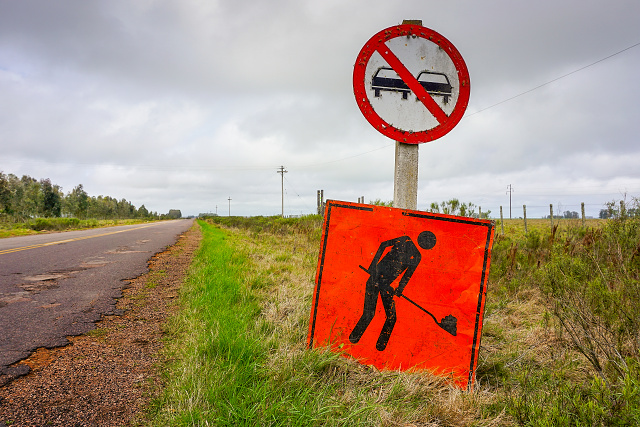
Near José P. Varela: Work progress of road builders is displayed on the board, with information of roadworks

Near Lascano: Roads repaired by piles of gravel
Treinta y Tres
By 16:30 I reached the town with the poetic name of "Thirty-three", thanks to the fact that the last 30 km were downhill and any uphills were mild. I used my usual strategy and headed to the best hotel in town, which is always well signposted, refused their price offer and asked about "hotél económico o hospedaje". They sent me to Olimar Hotel right on the square, where it cost half their price. CZK 450 ($23). Rather expensive there.
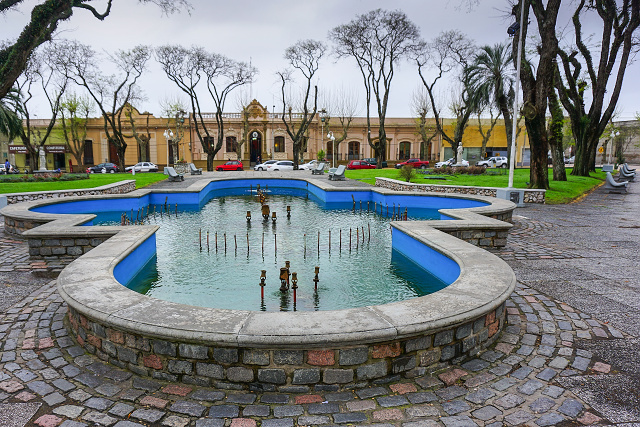
Treinta y Tres: Palace of Justice behind the pond with a fountain
I walked through the center which was rather small. I was fascinated by a huge 45-meter-high obelisk, erected in 1954 in honor of the city founders. The town is named after a revolutionary army group, Treinta Tres Orientales (Thirty-three Easterners), who in 1825 achieved the independence of the Oriental Province from Brazil and founded the present-day Uruguay.
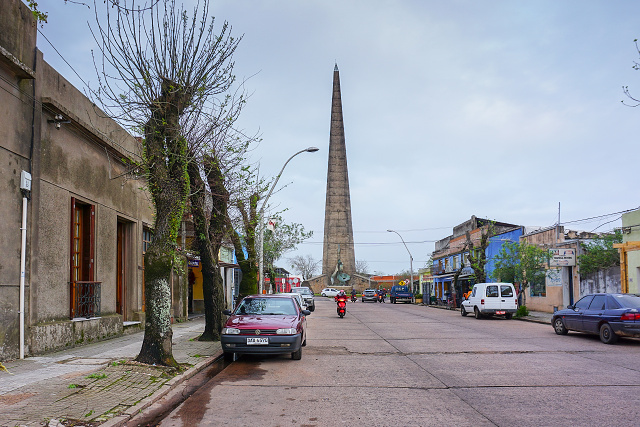
Treinta y Tres: The totally inappropriate huge obelisk, better suited to Washington, D.C.

Treinta y Tres: Comrades, finally go to hell with this!
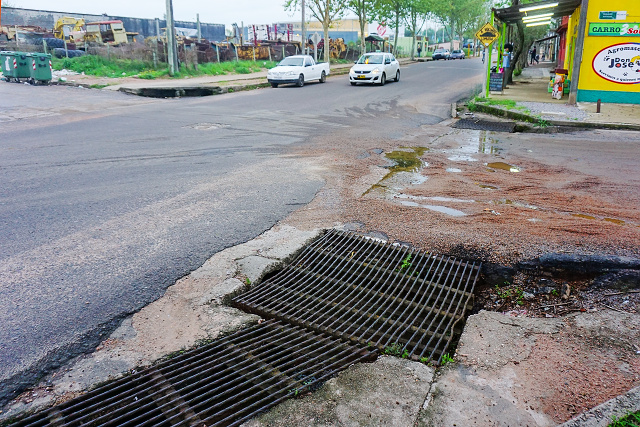
Treinta y Tres: Road and pavement conditions are definitely poor
I invested the money saved on accommodation in food, going to the town's best parrilla restaurant. Parrilla translates as 'grill', which means that they grill meat over an open fire in the restaurant. I ordered a full portion, as I never order half size, kids' meals, back home either. 15 minutes later, I received a 4 cm thick, 8 cm wide piece of meat, covering the 20 cm plate. It was well over half a kilo. Tasty meat, grilled medium-rare, as I had requested. I thought I would not manage it, as it was also accompanied by mashed potato and three types of salad. Nevertheless, I won. Using all my energy, I got it all in. The following day I would certainly have enough energy to tramp up all your hills, amigos!

Treinta y Tres: Ta-Ta supermercado at dusk
I slept in a bit, as I only had a short, 70-km road ahead of me. Surprisingly, it did not rain and remained so for the whole day. It was the first time in Uruguay that I did not need a rainproof jacket and pants. Throughout the day, it drizzled several times, but not for longer than 15 minutes, so my clothes did not even get damp.

Treinta y Tres: Promotional banner in flooded meadow
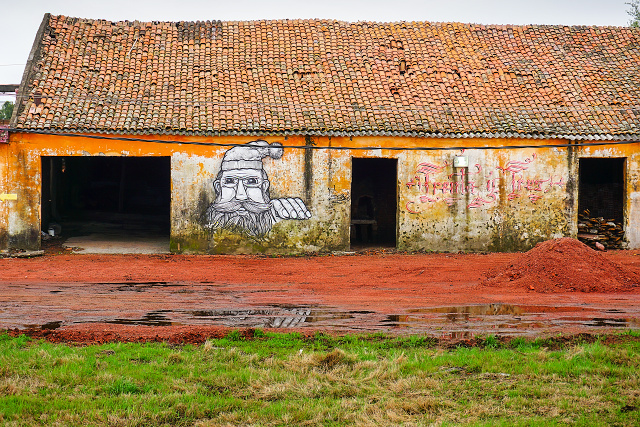
Treinta y Tres: Brickyard
I enjoyed the road, which only had a few hills, the first 30 km were top class – a smooth, flat surface with half a meter wide side lane. I was not in a hurry, I looked at the countryside and every now and then photographed it.
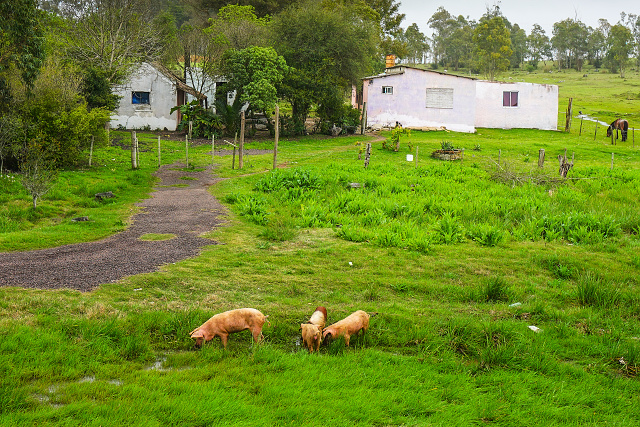
Near Treinta y Tres: Pig farm
By the way, I was extremely happy with my new Sony A6000 camera. The 24-75 mm telephoto lens was totally adequate, the focus worked well, the electronic camera monitor was great quality. I was satisfied with the quality of the photos. Moreover, this camera with APS-C format image sensor (the same as in amateur as well as semi-professional reflex cameras) can easily fit into my pocket. I purchased an automatic cover for it, which opens when the lens opens up. So I do not need to remove the cover by hand, which only delays everything.

Near José P. Varela: Gaucho greeting me

Near Lascano: Predator

Near Lascano: Horses
In José P. Varela, I exited Road 8 leading to Montevideo and entered the road towards Lascano. From here on Road 19, I would reach the north-eastern corner of Uruguay. Of course, the road was of poor quality, repaired with the local technique of filling with sub-standard cement. Some sections were dusty, a 4-km long section through an avenue of massive trees was terribly bad. However, I was not bothered by anything, I looked around me, was not stressed at all. Once again, I saw the local ostrich-like birds (nandu), but they were too far away to photograph. A few days earlier, I had seen many of them at close quarters, but had not risk to damage my camera in the heavy rain.

Near Rio Cebollatí: Several kilometers of unpaved road in avenue of tall trees
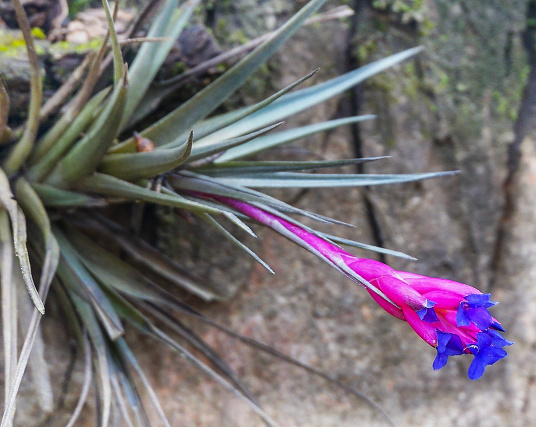
Near Rio Cebollatí: Parasitic flower growing on a tree trunk
In Lascano, which was a rather big and spread-out village, there was only accommodation in a hotel which reminded of American motels. I used the hosepipe in their yard to wash my bicycle and panniers. I got hold of a piece of cardboard to cover the back of my bicycle, used WD to spray the chain, gearbox, front derailleur, pedals and wires, then oiled the chain properly. I requested my clothes to be washed at the reception, I had really nothing left to wear. They asked me for 100 pesos, so I hoped they would deliver them dry the following day.

Lascano: Some older homes have their charm
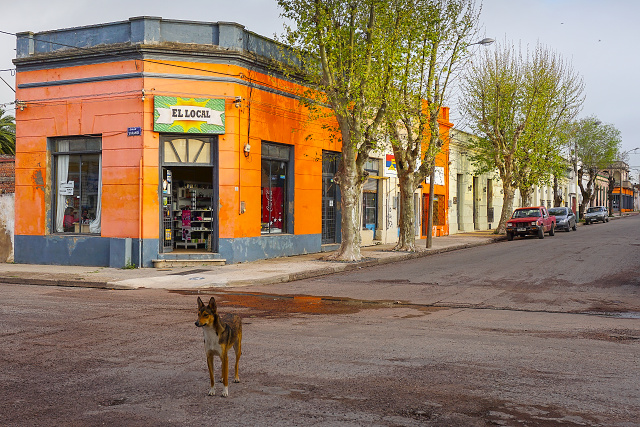
Lascano: El Local – this is where you find me in every town
I could not resist visiting the town. Interestingly, among all the architectonically poor and uninteresting surroundings, there sometimes appeared a well-designed building reminiscent of Spanish colonial towns. I purchased supplies for breakfast and a snack for the following day. The hotel breakfast was quite poor, even by local standards. I could cycle a maximum of 20 km on that. But the nicely dried laundry compensated well for it. I did not need to worry about clothes for a few days.
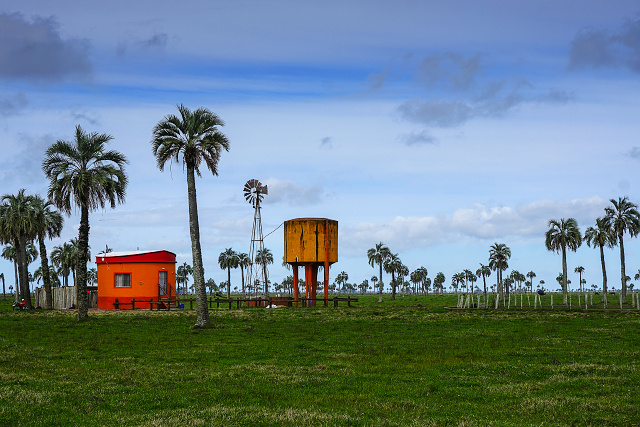
Road 15: Small farm
The route to Chuy was first on Road 15 and, thanks to the fresh wind blowing from behind in some sections, I pedaled along it quickly. 35 km later, the road turned almost 90 degrees to Road 19 and I had to battle against the wind. It was nothing dramatic, the road was flat, so almost perfect for cycling. Only the unpaved parts, composed of water-logged sand, dirtied my newly washed bicycle again. The more than 18-year-old bicycle could not impress anymore anyway.
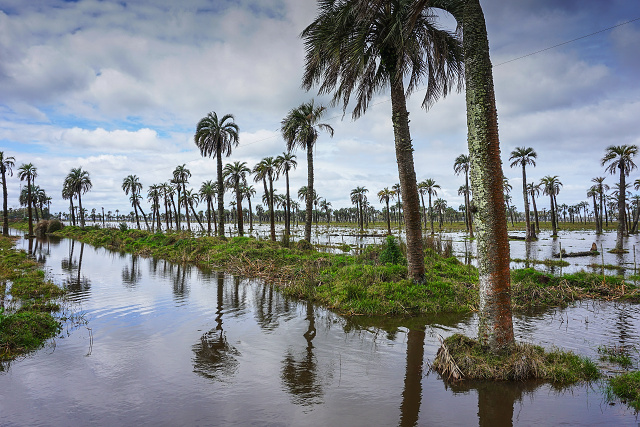
Road 15: Abundance of palms and vast flooded areas are typical of the region
Jóžin, a Czech character from a song, who lived in the swamps, would have felt at home there. There were swamps everywhere one looked. The most widespread were Banadas de la Indian Muerte and Banadas de San Miguel. The animals seemed to be used to them, horses and cows grazed in water up to their knees, stuffing themselves on the juicy grass growing in the water, seemingly unafflicted by rheumatism. It was a haven for birds who, together with frogs, provided a very loud sound chorus. Only the humans suffered. The access roads to farms were usually flooded in decimeters of water. I saw electricians in fishing gumboots up to their waists in water in order to reach an electric pole.

Road 15: Electricians in local swamps have a hard time
Fortín de San Miguel
At the end of 18. de Julio, I encountered the first hill worth mentioning that day. After that, there was a turn-off on to a sand road to Fortress San Miguel. I was truly lucky, as out of season, the place was open only on Wednesdays and Sundays. The army was still in charge of it and soldiers in uniforms even charged an entry fee (30 pesos).

Fortín de San Miguel: Large 18th-century St. Michael fortress
The fortress, first built by the Spanish in 1734 and, in 1737, was completed by the Portuguese. The solid stone building, today overgrown by red lichen, gives a very compact impression. I was surprised by the neatness of the building as well as how solid everything was.

Fortín de San Miguel: Before entering the fortress
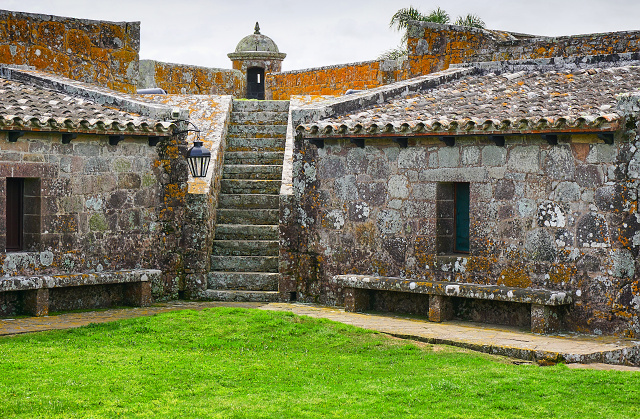
Fortín de San Miguel: Access to one of the towers
The interior serves as a museum to illustrate the life in ancient times, including an exhibition of army uniforms. Only the interior decor of the chapel is in the original state. I found the original toilets interesting. They were placed high up in the fortifications so that feces fell down outside the fortress. There must have been lines to them as there were only two for the whole fortress (the urinals were luckily slightly bigger).
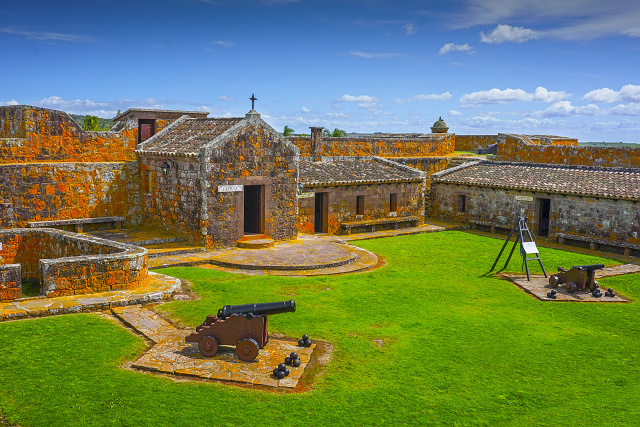
Fortín de San Miguel: Interior space dominated by the chapel
Pleasantly refreshed by the fortress visit, I reached Chuy 9 km later. I found accommodation in the local hostel, where I was the only guest. The beach season would start in two months, so there were no guests around. The only site were Duty Free Stores which take advantage of the town being divided by the border between Uruguayan and Brazilian parts. Nevertheless, if one did not know about it, the division would not even be noticeable. The border goes through the middle of the busiest street of the town, called Avenida Brasil on the Uruguayan side and on the Brazilian side, Avenida Uruguay.

Chuy: On the left Avenida Brasil (Uruguay), on the right Avenida Uruguay (Brazil)

Chuy: Duty free stores on Uruguayan side of the main avenue - Avenida Brasil
It was possible to notice it only on Sundays (which was my case), because the Uruguayan side was busy and on the Brazilian side everything was closed. I have to say that, compared to Ciudad del Este, that street was only a "weak cup of tea." Almost no street vendors, nobody aggressively trying to force one to buy anything, everything taking place in decent, polished air-conditioned stores. When it came to food, it was rather problematic. While hard, cheap alcohol was sold on every corner, it was difficult to locate a store selling bread and basic groceries.
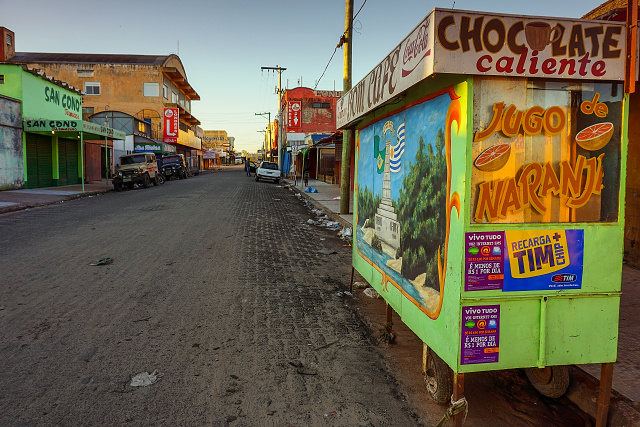
Chuy: Quiet Brazilian part of town on a Sunday
The following day, I would get my sight of the Atlantic Ocean, so this chapter can end in good conscience.
